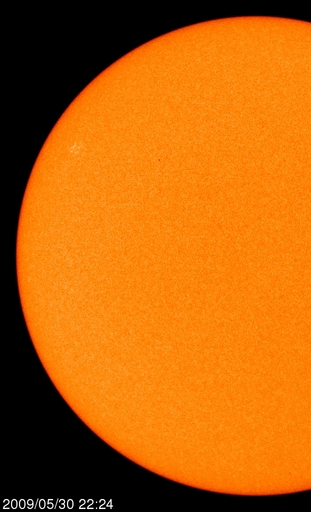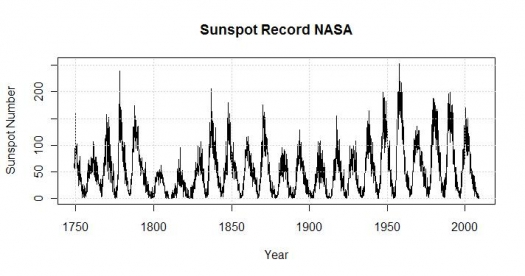[/caption] OK, I admit – the headline is a little over the top. But the sun has been so quiet of late, that even a small sunspot can be exciting. There's been some debate whether this period of extreme solar calm is truly unusual, or just part of the natural cycle. But solar cycle models never predicted this low amount of activity. "It turns out that none of our models were totally correct," admitted Dean Pesnell of the Goddard Space Flight Center, a member of an international panel of experts that are now trying to predict what the next solar cycle will hold. "The sun is behaving in an unexpected and very interesting way."
The panel is predicting that the next cycle, Solar Cycle 24 will have a peak sunspot number of 90, the lowest of any cycle since 1928 when Solar Cycle 16 peaked at 78.
Right now, the solar cycle is in a valley--the deepest of the past century. In 2008 and 2009, the sun set Space Age records for low sunspot counts, weak solar wind, and low solar irradiance. The sun has gone more than two years without a significant solar flare.
"In our professional careers, we've never seen anything quite like it," says Pesnell. "Solar minimum has lasted far beyond the date we predicted in 2007."
For 2009, the number of "spotless" days are 123, as of May 31, which is 82%.
There's a little sign of action on the sun, though. In recent months small sunspots and "proto-sunspots" are popping up with increasing frequency. Enormous currents of plasma on the sun's surface ("zonal flows") are gaining strength and slowly drifting toward the sun's equator. Radio astronomers have detected a tiny but significant uptick in solar radio emissions. All these things are precursors of an awakening Solar Cycle 24 and form the basis for the panel's new, almost unanimous forecast.
According to the forecast, the sun should remain generally calm for at least another year. This calm has a greater affect on Earth's atmosphere than you might imagine. With low solar activity, the Earth's atmosphere can cool and contract. Space junk accumulates in Earth orbit because there is less aerodynamic drag; hence the increase in the number of collision event "alarms" for the ISS and shuttles. The calm solar wind whips up fewer magnetic storms around Earth's poles. Cosmic rays that are normally pushed back by solar wind instead intrude on the near-Earth environment. There are other side-effects, too, that can be studied only so long as the sun remains quiet.
But the sun is a very chaotic place, and even a below-average cycle is capable of producing severe space weather from solar flares and coronal mass ejections (CME) said Doug Biesecker of the NOAA Space Weather Prediction Center. So we shouldn't be lulled into a false sense of security.
Sources:
Science@NASA
,
SpaceWeather.com
 Universe Today
Universe Today

